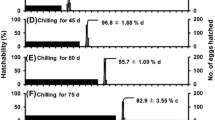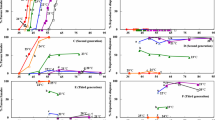Summary
The effect of the length of cold treatment on development time of embryos of eight Central European tettigoniid species was investigated in laboratory experiments, using chilling periods of 3, 4, 5, 6, 9, and 12 months. Two different types of response were observed: (1) The hatching date was not influenced by hibernation length (Conocephalus) or only after the 3-month cold treatment (Phaneroptera, Platycleis), or (2) The time required for post-diapause development was significantly reduced by each 1-month increase in the length of cold treatment up to 6 months (Meconema, Metrioptera, Tettigonia).
Thus, the correct timing of hatching is achieved by one of two different strategies. In lat-hatching species, the influence of hibernation length is small. Premature appearance is prevented by a high thermal threshold. In early-hatching species, the embryos are obviously able to measure the length of the chilling period. Thus, they gradually change their physiological state so that the potential speed of postdiapause development increases as the ‘winter’ is prolonged. This strategy can be understood as an adaptation to the necessity of hatching at low or moderate temperatures. Field experiments with two Tettigonia species confirm the laboratory data.
Similar content being viewed by others
References
Dean RL, Hartley JC (1977a) Egg diapause in Ephippiger cruciger (Orthoptera: Tettigoniidae) I. The incidence, variable duration and elimination of the initial diapause. J Exp Biol 66:173–183
Dean RL, Hartley JC (1977b) Egg diapause in Ephippiger cruciger (Othoptera: Tettigoniidae) II. The intensity and elimination of the final egg diapause. J Exp Biol 66:185–195
Hartley JC, Warne AC (1972) The developmental biology of the egg stage of Western European Tettigoniidae (Orthoptera). J Zool 168:267–298
Harz K (1957) Die Geradflügler Mitteleuropas. VEB Gustav Fischer Verlag, Jena
Helfert B (1980) Die regulative Wirkung von Photoperiode und Temperature auf den Lebenszyklus ökologisch unterschiedlicher Tettigoniiden-Arten (Orthoptera, Saltatoria) 2. Teil: Embryogenese und Dormanz der Filialgeneration. Zool Jb Syst 107:449–500
Helfert B, Sänger K (1976) Vergleichende Untersuchungen über die Temperatursummierung von Laubheuschrecken (Orthoptera: Tettigoniidae) während der Embryogenese. Zool Anz 196:43–60
Hodek I (1871) Termination of adult diapause in Pyrrhocoris apterus (Heteroptera: Pyrrhocoridae) in the field. Ent Exp Appl 14:212–222
Hodson AC, Weinman CJ (1945) Factors affecting recovery from diapause and hatching of eggs of the forest tent caterpillar, Malacosoma disstria Hbn. Tech Bull Minn Agric Exp Stn 170:1–31
Howe RW (1967) Temperature effects on embryonic development in insects. Ann Rev Entom 12:15–42
Ingrisch S (1978) Labor- und Freilanduntersuchungen zur Dauer der postembryonalen Entwicklung einiger mitteleuropäischer Laubheuschrecken (Orthoptera: Tettigoniidae) und ihre Beeinflussung durch Temperatur und Feuchte. Zool Anz 200:309–320
Ingrisch S (1979a) Untersuchungen zum Einfluß von Temperatur und Feuchtigkeit auf die Embryogenese einiger mitteleuropäischer Laubheuschrecken (Orthoptera: Tettigoniidae). Zool Beitr 25:343–364
Ingrisch S (1979b) Die Orthopteren, Dermapteren und Blattopteren (Insecta: Orthoptera, Dermaptera, Blattoptera) von Hessen. In: Müller P (ed) Fundortkataster der Bundesrepublik Deutschland Saarbrücken, Heidelberg, Teil 13, 1–99
Ingrisch S (1984a) The influence of environmental factors on dormancy and duration of egg development in Metrioptera roeseli (Orthoptera: Tettigoniidae). Oecologia (Berlin) 61:254–258
Ingrisch S (1984b) Embryonic development of Decticus verrucivorus (Orthoptera: Tettigoniidae). Entomol Gener 9: (in press)
Ingrisch S, Boekholt I (1983) Zur Wahl des Eiablageplatzes durch mitteleuropäische Saltatoria. Zool Beitr 28:33–46
Masaki S, Ando Y, Watanabe A (1979) High temperature and diapause termination in the eggs of Teleogryllus commodus (Orthoptera: Gryllidae). Kontyu 4:493–504
Monatlicher Witterungsbericht (1981–83) Deutscher Wetterdienst (ed), Offenbach/M, vol 29–31
Müller HJ (1970) Formen der Dormanz bei Insekten. Nova Acta Leopoldina 35:1–27
Oschmann M (1969) Faunistisch-ökologische Untersuchungen an Orthopteren im Raum von Gotha. Hercynia 6:115–168
Sachs L (1978) Angewandte Statistik 5. Aufl. Springer-Verlag Berlin, Heidelberg, New York
Sänger K (1980) Zur Phänologie einiger Saltatoria (Insecta: Orthoptera) im pannonischen Raum Österreichs. Zool Anz 204:165–176
Tauber MJ, Tauber CA (1976) Insect seasonality: Diapause maintenance, termination, and postdiapause development. Ann Rev Entom 21:81–107
Waldbauer GP (1976) Phenological adaption and the polymodal emergence patterns of insects. In: Dingl H (ed) Evolution of insect migration and diapause, Springer-Verlag, New York, Heidelberg, Berlin, pp 127–144
Author information
Authors and Affiliations
Rights and permissions
About this article
Cite this article
Ingrisch, S. Effect of hibernation length on termination of diapause in European Tettigoniidae (Insecta: Orthoptera). Oecologia 65, 376–381 (1985). https://doi.org/10.1007/BF00378912
Received:
Issue Date:
DOI: https://doi.org/10.1007/BF00378912




